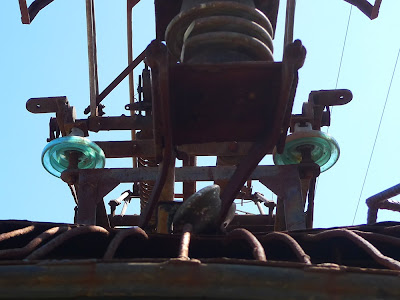 |
| Pantograph assembly: Hershey Cuban Railway started with steam but soon went electric. |
I join dozens of people already on the platforms, some awaiting the train I want to take to Havana, others the one coming from the other direction and heading west. Hershey is the only place with two lines of track where trains can pass; elsewhere there's just one line.
The trains pull in within moments of each other, close to if not exactly at the scheduled 7:40 a.m. arrival time. Each is formed of two linked cars, their spindly pantograph frames reaching up like insect antennae to draw power from the overhead lines.
It's easy to imagine the cars, windows dulled with grime, sides and even roofs scarred by rust, as the line's 1922 originals.
 |
| Spanish-built cars were a gift to Cuba. |
Hershey was an enlightened employer, and the town that bore his name would be much like the community he built for his workers in Pennsylvania. The residents had health care, a free school and recreational facilities, including the all-important baseball diamond.
To carry more workers to the mill and its product to the ports of Havana and Matanzas, Hershey built a railroad. The first trains were powered by steam, but by 1922 they were being replaced with the new electric technology. Soon the Hershey Cuban Railway would have seven electric locomotives and 17 electric cars – its passenger service had quickly become popular – running on 135 kilometres of electrified main line and branches.
Hershey's Cuban properties were sold to the Cuban Atlantic Sugar Co. in 1946. Following the communist takeover the town (though not the station) was renamed Camilo Cienfeugos after the revolutionary hero, and the mill kept pressing out sugar until 2002.
The original U.S.-built Brill rail cars were repaired again and again and might still be in service had Spain not donated a fleet of used electric cars to Cuba in 1998. Some dated to 1944 – no wonder they look like antiques – but they were still a step up from their well-used predecessors.
Literally.
The floors of the Spanish cars were much higher than the Brills', requiring the installation of a raised platform at Hershey and concrete steps at other stops.